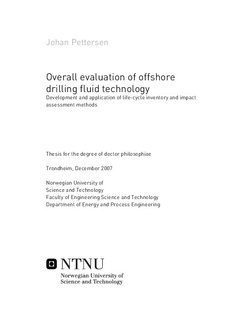| dc.contributor.author | Pettersen, Johan | nb_NO |
| dc.date.accessioned | 2014-12-19T11:43:36Z | |
| dc.date.available | 2014-12-19T11:43:36Z | |
| dc.date.created | 2008-01-18 | nb_NO |
| dc.date.issued | 2007 | nb_NO |
| dc.identifier | 123306 | nb_NO |
| dc.identifier.isbn | 978-82-471-5627-8 | nb_NO |
| dc.identifier.uri | http://hdl.handle.net/11250/233345 | |
| dc.description.abstract | The goal of this thesis is to provide the means for discussion of overall benefits of alternative offshore drilling technologies. Life-cycle assessment is used to assess environmental impact of alternative drilling technologies. Life-cycle assessment is well-suited for relative comparison and it offers the broad perspective necessary to evaluate overall performance.
Several methodological developments are made within the framework of life-cycle assessment to support the evaluation of offshore drilling fluid technology.
Offshore discharges to the marine environment during drilling operations are pulse emissions. The relative marine aquatic ecotoxic impact of pulse emissions compared to continuous emission processes is investigated by transient dispersion modeling.
Occupational health is an important decision objective for offshore operations. Crane-lifts are an important cause of accidents with human health damages on drilling rigs. A characterization factor for offshore crane-lifts is developed to include occupational health in life-cycle assessment.
Long-term release of metals from solid wastes is important for the ecotoxicity of drilling wastes. A review is presented that considers the current and possible solutions to address long-term leaching processes in life-cycle assessment.
An overall evaluation of offshore drilling fluid technology is performed. The study assesses the relative life-cycle performance of alternatives for density control in drilling fluids (ilmenite versus barite), offshore loading systems (crane-lifts versus a hydraulic system), base drilling fluids (water-base versus oil-base), and waste treatment of cuttings drilled with water-based drilling fluid (offshore discharge versus onshore treatment). A well located in the Barents Sea is used as reference.
Results are interpreted using Monte Carlo simulation. Preferred alternatives from an overall evaluation are proposed.
This thesis illustrates the challenges of life-cycle assessment. Most product systems require adaptation and development of methods for proper evaluation of impacts and results that meet requirements for decision objective attributes. | nb_NO |
| dc.language | eng | nb_NO |
| dc.publisher | Fakultet for ingeniørvitenskap og teknologi | nb_NO |
| dc.relation.ispartofseries | Doktoravhandlinger ved NTNU, 1503-8181; 2007:251 | nb_NO |
| dc.relation.haspart | Pettersen, Johan; Peters, Glen P; Hertwich, Edgar G.. Marine ecotoxic effect of pulse emissions in life cycle assessment. Environmental Toxicology and Chemistry. 25(1): 297-303, 2006. | nb_NO |
| dc.title | Overall Evaluation of Offshore Drilling Fluid Technology: Development and Application of Life- cycle Inventory and Impact Assessment Methods | nb_NO |
| dc.type | Doctoral thesis | nb_NO |
| dc.contributor.department | Norges teknisk-naturvitenskapelige universitet, Fakultet for ingeniørvitenskap og teknologi, Institutt for energi- og prosessteknikk | nb_NO |
| dc.description.degree | PhD i energi- og prosessteknikk | nb_NO |
| dc.description.degree | PhD in Energy and Process Engineering | en_GB |
